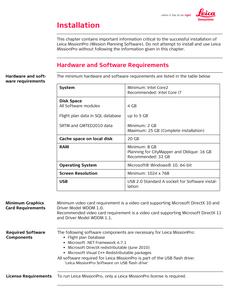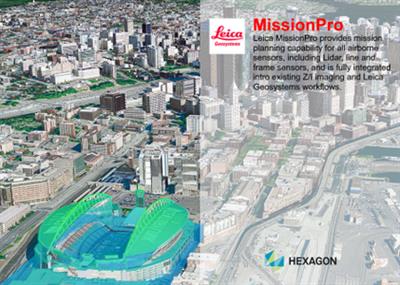
Leica Hexagon MissionPro 12.9.0 | 1.3 Gb
Product:Leica Hexagon MissionPro
Version:12.9.0
Supported Architectures:x64
Website Home Page :
https://leica-geosystems.com/Languages Supported:english
System Requirements:Windows *
Size:1.3 Gb
Leica Geosystems Geospatial Solutions Division is pleased to announce today the release of its new mission planning software, Leica MissionPro 12.9.0. The software provides mission planning capability for all airborne sensors including LiDAR, line and frame sensors and is fully integrated into existing Z/I Imaging and Leica Geosystems workflows.
Leica MissionPro 12.9.0 release
This is a full release of Leica MissionPro 12.9.0. This software release is only supported on Microsoft Windows 10 64-bit operating systems
Leica MissionPro 12.9.0 is released for the following sensor systems
- Leica ContentMapper
- Leica CityMapper-2
- Leica TerrainMapper-2
- Leica TerrainMapper
- Leica CityMapper
- Leica CityMapper with TerrainMapper option
- Leica DMC III
- Leica ADS100 with SH100/SH120
- Leica ALS80
- Leica RCD30
- Leica RCD30 Oblique
- Leica Topobathymetric Lidar systems:
. Leica Chiroptera-5
. Leica HawkEye III
. Leica Chiroptera II
. Leica DragonEye
- Leica SPL100 systems
Leica MissionPro 12.9.0 Features, Fixes, Changes and Open Issues
New Features
Support Chiroptera-5 planning
Planner can plan for the Leica Chiroptera-5 system. Always select Chiropter-5 in List of Sensors when creating Chiroptera-5 flight plans.
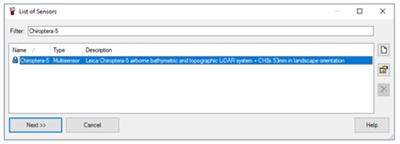
Combined Raster QC Footprints
Planner can now export a single Raster QC Footprint file for the complete AOI for the planned nadir GSD or point density values.
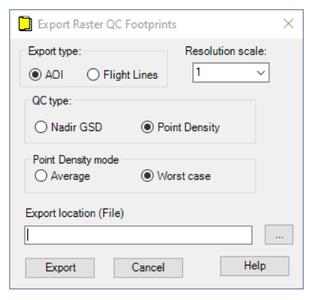
Planner can export a single image (of the AOI) or multiple images (of the Flight Lines) as the Export type.The default value for the Resolution Scale is 1. A Resolution Scale value of 1 means that the image pixels are the same size as the pixels of the DTM. The Resolution Scale value is used a multiplier of the DTM pixel size. A Resolution Scale smaller than 1 would mean more pixels in the image for the same extent but not more information.
An AOI, or each flight line in an AOI is exported as raster data in a separate GeoTIFF file. The nadir GSD or point density values are saved as 32-bit floating number values in the GeoTIFF file. The GeoTIFF file is automatically projected to the WGS 84 Geographic coordinate system (EPSG code 4326). Any coordinate system can be selected for the flight plan in Leica MissionPro. The file names of the GeoTIFF files are taken from the names of the flight lines or the AOI.
The GeoTIFF raster size is the same resolution as the DTM raster size used in computation when the Resolution Scale value is 1. When the AOI or flight line covers more than one DTM, the exported GeoTIFF raster size is taken from the DTM with the smallest raster size.
Multiple columns in Project and Data View with different units
Planner can add the same element multiple times to Property View and Data View. Every column can have a different unit.
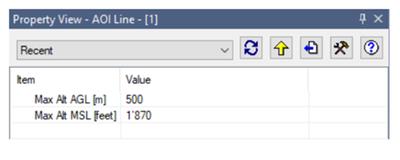
To add the same element more than once:
1. Select Allow duplicate columns in Customize Data View
2. Select an entry in the Available list
3. Double-click the entry or click the Right arrow button
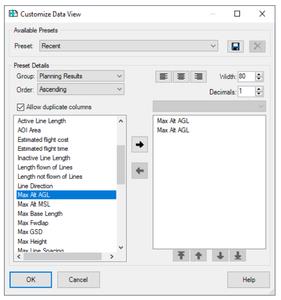
The Unit and Decimals properties can be set separately for each of the multiple entries in the Show list.
Side Overlap in distance
The minimum and maximum Side Overlap values between adjacent flight lines are now available in distance and percentage.

To show the Side Overlap in distance:
1. Open Customize Data View
2. Select in Available list
- Max Side Overlap Distance
- Max Side Overlap Distance
3. Double-click the entries or click the Right arrow button
Set the Unit and Decimals properties for Max Side Overlap Distance and Max Side Overlap Distance for both columns.
Fixes
Leica MissionPro 12.9.0
- Planning: Fixed issue where additional lines were generated for ContentMapper flight plans.
- Planning: Removed incorrect Not all objects could be calculated error message when computing multiple AOIs
- AeroPlan: Sensor Type is again available in Image Sensor tab in AeroPlan. Nadir camera was missing for some systems.
Changes
Leica MissionPro 12.9.0
General
- Export: The Microsoft Excel export format is again recognized as a valid Microsoft Excel file format.
Open Issues
Leica MissionPro 12.9.0
- Help: Context-sensitive help is not working. When pressing the F1 key in a dialog, MissionPro does not open the Leica MissionPro User Manual in the right location. Leica MissionPro User Manual is always opened on the first page

Leica MissionProis the mission planning software for all Leica Geosystems airborne sensors across multiple product generations. The unique 3D virtual globe interface and the advanced computation algorithms simplify and speed up your mission planning.
Leica MissionPro is a Software for mission planning for all types of sensors including Leica CityMapper, Leica TerrainMapper, Leica ADS100, Topobathymetric LiDAR systems, Leica ADS80, Leica ALS80, Leica ALS70, Leica RCD30, Leica RC30, Z/I DMC, Z/I DMC II, Z/I DMC IIe, Leica DMC III and any other film or digital frame, line or ON/OFF sensors.
Generate effective flight plans by selecting area, sensor and acquisition parameters. Evaluate the mission quickly and thoroughly right after execution, regardless of project size. Evaluate your flights, run quality control, prepare reporting and manage projects.
Leica Geosystems Airborne Bathymetric Solutions
Leica Geosystems 4X bathymetric product line increase the point density by factor 4 compared to previous versions. The airborne bathymetric LiDAR sensors provide seamless data from water to land and seafloor coverage of up to 50 m water penetration. Combined with Leica LiDAR Survey Studio they offer a complete solution for hydrographic surveying.
Hexagonis a global leader in digital reality solutions, combining sensor, software and autonomous technologies. We are putting data to work to boost efficiency, productivity, quality and safety across industrial, manufacturing, infrastructure, public sector, and mobility applications. Our technologies are shaping production and people-related ecosystems to become increasingly connected and autonomous - ensuring a scalable, sustainable future.
